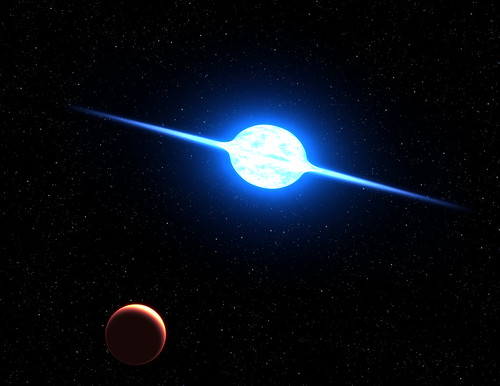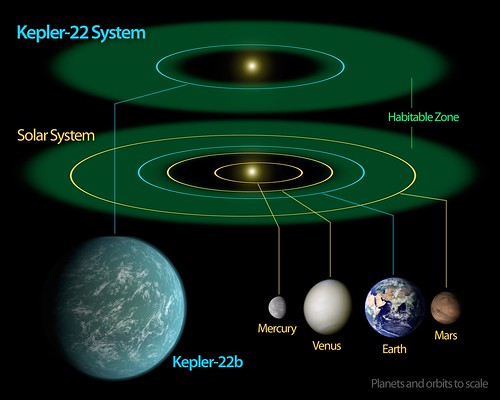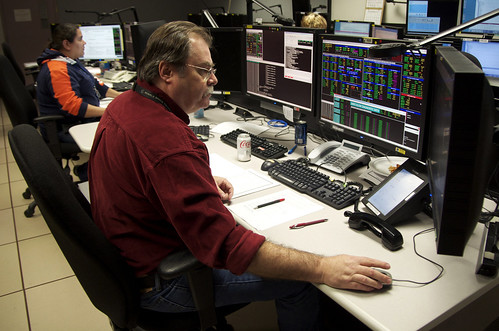Awesomeness Round-Up – 12/7/2011
- By Sara Mitchell
- December 6, 2011
- Comments Off on Awesomeness Round-Up – 12/7/2011
While scientists have discovered hundreds of extrasolar planets over the past decade, finding Earth’s twin (an Earth-like planet in a similar orbit to ours around a Sun-like star) has been much more difficult. But a recent discovery by the Kepler mission has brought us one step closer – planet Kepler-22b is 2.4 times the radius of Earth, orbiting within the habitable zone (the region where an Earth-like planet could maintain liquid water on its surface) around a host star slightly smaller and cooler than our Sun. Kepler’s observations have identified several dozen other habitable zone planet candidates, and the mission will continue watching these objects as they transit in front of their host stars to see if more potential Earth twins are found.
This video reveals the secret life of the constellation Cygnus, starting with optical and infrared imagery and moving to radio, infrared, and gamma-ray data as we enter the “star factory” that is Cygnus X. It takes observations in multiple wavelengths of light for astronomers to study the star birth and death occurring in this region. The Fermi Gamma-ray Space Telescope recently discovered something special about Cygnus X – it’s a powerful cosmic ray accelerator, sending young particles zinging into space and generating gamma rays as they interact with with gas in the region. Scientists are eager to further explore these particles as they begin their voyages.
Ever wondered what it’s like to work in mission control for a satellite? These behind-the-scenes photos show the Hubble Space Telescope’s Mission Operations Room (MOR) here at Goddard, as flight controllers Jade Kukula and Glen Curtis work at their consoles.
Want to get the hottest Christmas gift around? It’s a gamma-ray burst! GRB 101225A was discovered on December 25, 2010, by Swift’s Burst Alert Telescope. Besides its special birthdate, this burst is an eccentric one – scientists have found two very different models that explain its creation. This video explores the possibilities. As a related press release puts it, “Stars seem to find many different ways to die.”

Credit: NASA, ESA, and G. Bacon (STScI)
What’s young, hot, and spinning very fast? Blue giant star VFTS 102 is the fastest spinning star that astronomers have discovered, rotating 1 million miles per hour (that’s 100 times faster than our Sun). The star is also speeding through space at an unexpectedly fast pace, especially compared to its neighbors, leading researchers to suspect that it might be a runaway star ejected violently from a binary system after its companion exploded as a supernova. A pulsar and supernova remnant observed nearby support this story of a short, dramatic life for VFTS 102.
Earlier this year, we talked about two Goddard scientists’ proposed presentation for TED about the James Webb Space Telescope. After an in-person audition, their talk wasn’t selected for the big annual TED conference… but the organizers of TEDxMidAtlantic 2011 invited Dr. Jane Rigby to speak at their event in Washington, DC! The video is up for you to enjoy the talk at home (with additional coverage by Geeked on Goddard).
When NASA launched Voyager 1 in 1977, I doubt that anyone imagined that it would still be in good health in 2011, now 11 billion miles from the Sun! Although that’s the farthest that any manmade object has traveled into space, it’s still within the influence of the Solar System. The spacecraft has now entered what scientists call the stagnation region, an area with decreased solar wind activity, increased magnetic fields, and other indicators that the satellite is approaching the boundary of interstellar space. This is truly uncharted territory, and we look forward to seeing many more discoveries from Voyager 1 (and its sister, Voyager 2, now 9 billion miles from the Sun).
We’ll leave you with these photos taken around Goddard as we enter meteorological winter. Brrr!









